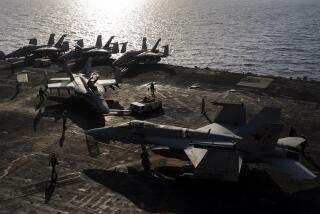Seabees May Come Home This Month : Gulf War: One battalion should be on its way within weeks, but two construction units might have to wait.
- Share via
Two battalions of 1,200 Seabees from Port Hueneme Navy base are expected to return home from the Persian Gulf beginning this month after completing their mission of building barracks and other facilities for Marines, the base’s commander said Thursday.
Capt. R. J. Pearson III said the Seabees’ role in the Gulf War was to support the Marine Corps, which announced its plans to pull out of the region in the near future.
“Since the Seabees are there in support of the Marines, we are anticipating that our role is almost over,” Pearson said. Pearson cautioned that the Seabees have not received official word that their engineers and construction crews can begin to pack up their equipment and return home.
Nevertheless, Pearson said the 600-man Naval Mobile Construction Battalion 40 should return to Port Hueneme on schedule early this month, unless it is delayed in the competition with other U.S. troops for military aircraft headed to the United States.
“We were waiting for some time for aircraft to get over there,” Pearson said. “We can speculate that it will go a little faster to get out, but there will be plenty of competition for aircraft going home.”
He said Battalion 5, the other 600-man unit in Saudi Arabia, and a smaller underwater construction team should return as soon as their mission is completed in the next few months.
Spokesmen for the Navy reserves and the California Air National Guard in Ventura County had no information about when reservists might return home.
“The war is over and we are waiting to hear a day when they’re coming home,” said Petty Officer Joe Parker, a spokesman for Naval Air Reserves at Point Mugu. One reserve unit in the Gulf from Point Mugu is a helicopter detachment trained to retrieve downed pilots behind enemy lines.
Maj. Michael Ritz, spokesman for the Channel Islands Air National Guard Base near Point Mugu, said he had no word on the return of the more than 150 reservists in the Gulf. Most of those reservists are nurses and medical technicians who stabilize the wounded and airlift them to military hospitals.
“We have had people directly involved in combat and thankfully no casualties whatsoever,” Ritz said.
The Navy reserves have reported no casualties from Ventura County, nor has the Navy announced any combat-related injuries or deaths of Seabees from the Naval Construction Battalion Center at Port Hueneme.
Pearson said that the Gulf War has not been without strains and sacrifices, and he expressed his appreciation for supportive family members over the past seven months.
Unlike most military units, Seabees depart routinely for overseas missions on a regular rotation of seven months at Port Hueneme and seven months abroad. Although Seabees were reassigned to Saudi Arabia during the military buildup, the rotation continued on schedule when one battalion was allowed to return home in December.
If the schedule continues, the Naval Mobile Construction Battalion 3 will depart from Port Hueneme in March. Pearson said it has not been decided if the battalion will go to the Gulf or traditional ports in Okinawa, Spain, Puerto Rico or Guam.
Pearson also declined to speculate if Seabees might be ordered to help the U.S. Army Corps of Engineers rebuild war-damaged Kuwait or construct facilities for international peacekeeping forces to occupy a demilitarized zone planned along the Kuwaiti-Iraqi border.
“Our mission to date has been in support of the Marines,” Pearson said. He said he anticipated that Seabees would follow the lead of Lt. Gen. Walter E. Boomer, head of the Marine Corps in the Middle East, who announced Thursday that his troops will not remain in the region as an occupying force.
More to Read
Sign up for Essential California
The most important California stories and recommendations in your inbox every morning.
You may occasionally receive promotional content from the Los Angeles Times.










